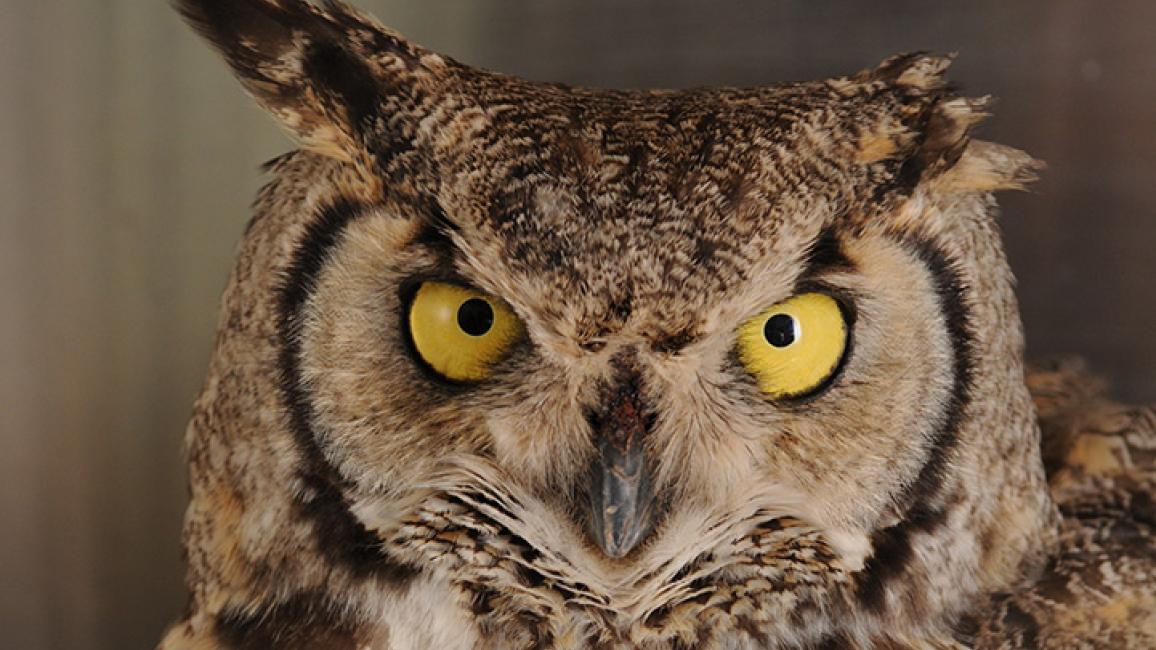Rescuing a great horned owl

It seemed like serendipity when a great horned owl landed at the Sanctuary on a late spring day. For some reason, the young adult owl was struggling to survive. In fact, he was starving and needed help fast. Luckily, he’d found his way to exactly the right place ― Wild Friends, Best Friends’ state and federally licensed wildlife rehabilitation center.
A great horned owl lands
The owl landed under a tree right next to Wild Friends’ great horned owl enclosure. Though it was one of the best places he could have landed, he wasn’t out of the woods yet. A group of wild turkeys and ravens discovered him and was squawking and clucking at him, revealing his hiding place under the tree. Flustered, the owl puffed up his feathers in an attempt to scare off the birds heckling him.
Troy Snow, a wildlife rehabilitator for Best Friends, saw the commotion and rushed to owl’s aid. But as soon as the owl caught sight of Troy, he took off and flew away with six or seven ravens chasing after him. The very next day during the Wild Friends tour, as the group was approaching the great horned owl enclosure, Eric, the tour's guide, told the story of what had happened the day before.
Suddenly, a visitor interrupted him to say, "Hey look! There's another owl under that same tree." It was the same owl, only this time he wasn’t strong enough to get off the ground. Wild Friends caregivers and rehabilitators leapt into action, surrounded the owl and got a towel over him.
More about Wild Friends at Best Friends
Rescuing a starving great horned owl
The owl didn’t have the energy to struggle. Beneath his feathers his body was painfully thin and dangerously dehydrated. He’d lost most of his tail feathers, so although he could still fly close to the ground, he couldn’t really take off. He also had injuries to his wrist and his face.
If he hadn't landed where he did when he did, he might not have lasted even another few days, according to Carmen Smith, licensed wildlife rehabilitator and manager of Wild Friends.
Though no one knew what had happened to the grounded owl, he was a classic example of what Wild Friends staff call a “first-year failure-to-thrive case”.
Getting help at Wild Friends
“Isn’t it incredible that he came here ― to Wild Friends of all places to get help?” Troy says. That serendipitous landing truly saved the owl’s life.
Although the owl desperately needed food and water, he was so emaciated that Wild Friends rehabilitators had to slowly hydrate and feed him so that he wouldn’t get refeeding syndrome. That is what can happen when the body gets overwhelmed with too much food too fast. At that point, the animal cannot keep anything down and gets sicker and less stable. But with diligent help from rehabilitators, the owl was successfully eating solid foods again after the first week.
Fast forward to a few months later and the owl is at a healthy weight, his abrasions have healed and his tail feathers have grown back.
Now, with the owl in the final stages of rehabilitation, wildlife rehabilitators are watching the owl closely. If he can show that he has the strength, skills and stamina to survive on his own, he’ll be released back into the skies. And should he ever need help again, he’ll know just where to land.
Photo by Best Friends staff